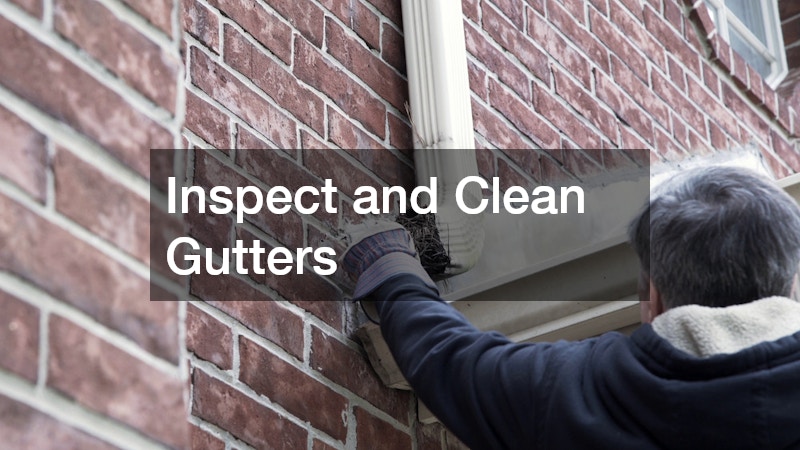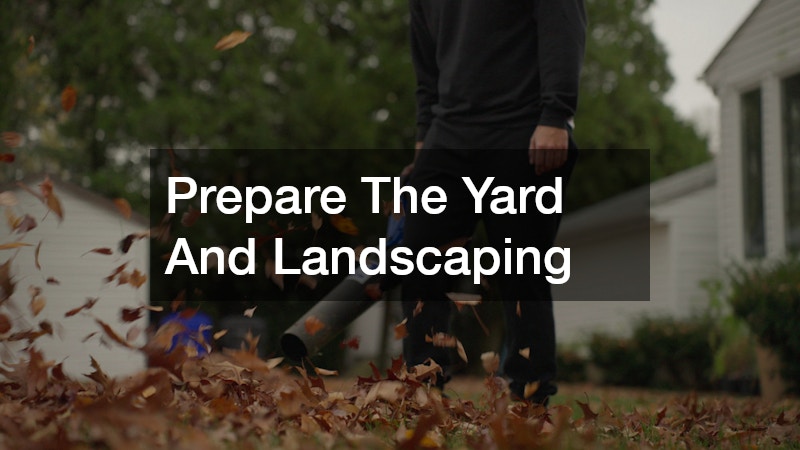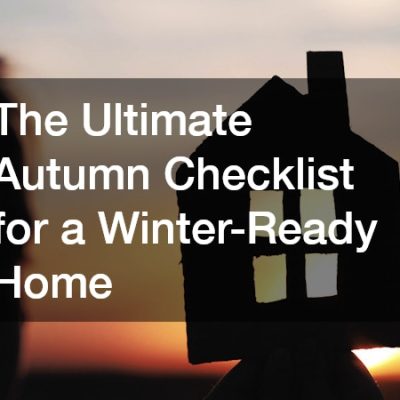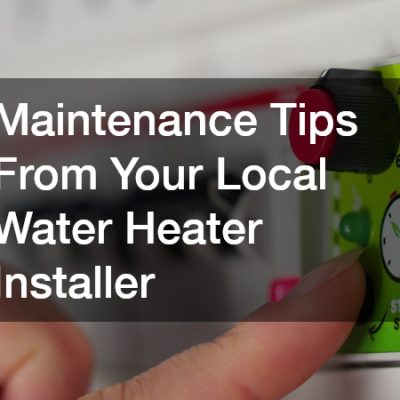As autumn arrives with falling leaves and cooler temperatures, it’s time to shift focus from summer fun to seasonal home maintenance. Fall is the perfect opportunity to prepare your home for the challenges of winter, from freezing temperatures to unpredictable storms. Whether you’re a new homeowner or a seasoned pro, having a solid list of tips for homeowners makes all the difference.
This guide offers 12 practical fall tips to keep your home running efficiently and safely. From clearing gutters to servicing your HVAC system, each tip is designed to protect your investment, prevent costly repairs, and create a warm, comfortable environment for the season ahead. Some tasks can be handled on your own, while others may call for experts.
1. Inspect and Clean Gutters

One of the most crucial fall tips for homeowners is to clean and inspect the gutters. Falling leaves and debris can easily clog your gutters, leading to water overflow that damages your roof, siding, and even your home’s foundation. Consider hiring a professional gutter installation company if your current system is outdated or damaged. Upgrading your gutters now can prevent major issues down the line.
A proper gutter system ensures that water flows away from your home, reducing the risk of mold, mildew, and erosion around the foundation. It also protects fascia boards and reduces the chances of ice dams forming in the winter. While you’re at it, take a walk around your property and make sure downspouts are angled away from your foundation. Clogged or misaligned downspouts can cause water to pool, weakening your structure over time. If you’re unsure whether your gutters are in top shape, a gutter specialist can help assess and suggest improvements. Some deck builder professionals also offer gutter inspections when working on adjacent outdoor spaces, so don’t hesitate to ask during your fall maintenance check.
2. Service Your HVAC System
Your heating and cooling system works hard throughout the year, especially during the transition from summer to fall. Having your HVAC system professionally inspected and serviced is key to maintaining a comfortable indoor climate and avoiding unexpected breakdowns when temperatures drop.
One of the most often-overlooked fall tips for homeowners is replacing air filters. Clean filters improve air quality and system efficiency. If you notice inconsistent heating or strange noises, contact a professional specializing in local HVAC repairs for a seasonal tune-up. Fall is also a smart time to have ductwork inspected for leaks or blockages that might hinder airflow. Efficient heating in the cooler months means reduced energy bills and a cozier home. If you use home water softeners and they’re integrated into your HVAC system or plumbing, ensure they’re functioning properly. Mineral buildup can affect both your water and heating systems if left unchecked. Regular inspections prevent long-term damage and help identify small problems before they become big ones.
3. Seal Gaps and Insulate
Drafts around doors, windows, and even electrical outlets can significantly increase your heating bill. A little weatherstripping and caulking can go a long way toward keeping your home warm and energy-efficient. This is one of the easiest fall tips for homeowners that also saves you money.
For more extensive energy-saving upgrades, such as adding insulation to the attic or walls, it’s a good idea to consult a professional. If your home is on uneven terrain or in a flood zone, elevated home builders are especially skilled at identifying where insulation can be added most effectively to protect from moisture and cold. Don’t forget to check lesser-known spots like attic hatches, recessed lighting, and chimneys, where air often escapes. These fixes don’t just save money—they make your home feel more comfortable throughout the winter. Insulating your water heater and pipes can also help reduce heat loss. Consider doing a full energy audit to uncover hidden inefficiencies. Even small fixes—like installing insulated curtains or foam outlet sealers—can make a big difference.
4. Protect Outdoor Plumbing

As temperatures dip, unprotected outdoor plumbing becomes vulnerable to freezing and bursting. Drain garden hoses, turn off outdoor faucets, and insulate exposed pipes. Frozen pipes can lead to costly water damage inside and outside your home. This tip is simple but crucial in colder climates.
If you’re using home water softeners, ensure they are properly winterized too, especially if they’re located in a garage or other unheated area. A burst pipe in winter can also disrupt your heating system and cause a chain reaction of issues. Installing frost-proof hose bibs or pipe sleeves can prevent freezing and add peace of mind. While you’re at it, check basement and crawl space vents for drafts—these areas often contain plumbing lines that are vulnerable to the cold. Have a plumber inspect irrigation systems or sprinkler lines that may need to be blown out before freezing weather. If you’re unsure about how to winterize your plumbing properly, calling a professional plumber or HVAC technician can be a smart move. It’s always better to be safe than sorry when it comes to your water lines in the fall.
5. Schedule a Heating Inspection
No one wants to find out their heating system isn’t working during the first frost. One of the smartest fall tips for homeowners is to get your furnace checked before you need it. Call a reputable heating company to inspect the system, clean the burners, and test for carbon monoxide leaks.
Routine maintenance not only prevents breakdowns but also extends the life of your heating unit. They’ll check gas connections, pilot lights, and thermostats to make sure everything is functioning safely. A heating professional can also recommend whether it’s time to upgrade your system for better energy efficiency. If your furnace is over 15 years old, it may be worth exploring options that will lower energy bills in the long term. Make sure your carbon monoxide detectors are also functioning—an essential step for any home with a furnace or fireplace. Consider also having your chimney inspected and cleaned if you use it regularly. Early fall appointments fill up quickly, so book now to avoid the winter rush. Regular heating maintenance also benefits air circulation, so tie this into your broader HVAC system upkeep.
6. Prepare the Yard and Landscape
Autumn is the perfect time to prep your yard for the dormant winter season. Rake up fallen leaves, cut back perennials, and plant spring bulbs. Not only will this improve curb appeal, but it also helps your landscaping come back strong next year. Getting ahead is one of the best fall tips for homeowners.
Many landscaping companies offer fall cleanup services, including fertilizing the lawn, pruning shrubs, and aerating the soil. These tasks are essential for keeping your yard healthy and vibrant. Cleaning up leaves also prevents mold growth and deters pests. It’s also the perfect time to overseed your lawn, especially in cooler climates where grass roots thrive in fall temperatures. While you’re tending to your lawn, consider installing garden edging or mulch to protect plants from frost and improve moisture retention. If you have a patio or backyard entertaining area, this is also a great time to inspect lighting and make any upgrades before winter darkness sets in. For hardscape features like retaining walls or walkways, consult a commercial concrete contractor to ensure they’re stable and won’t shift due to freezing and thawing.
7. Trim Trees and Branches

Tree limbs that hang too close to your house or power lines pose a danger during storms or heavy snow. Hiring a tree trimming service to remove dead or overhanging branches can prevent major property damage and ensure safety.
This is one of those fall tips for homeowners that’s often forgotten until it’s too late. Proactive trimming can also improve the overall health of your trees and prevent insect infestations. Dead branches become brittle in cold weather, posing a greater risk during heavy snowfall or high winds. If you have large trees near your roof or driveway, it’s especially important to inspect them for stability. Professionals can assess root health, signs of disease, and recommend long-term care strategies. Fall is also a good time to prune fruit trees, which can encourage better yields in spring. Keeping your trees healthy isn’t just about aesthetics—it’s a long-term safety investment. If your home is built on a slope or includes decks close to tree lines, your deck builder may also suggest clearance requirements to maintain safety and structural integrity.
8. Inspect the Roof
The roof is your home’s first line of defense against the elements. Before winter sets in, inspect your roof for damaged or missing shingles, signs of leaks, and worn flashing. A professional inspection is recommended if you’re unsure of what to look for.
If your home is custom-built or elevated, consider working with elevated home builders who specialize in structures designed for unique terrain or flood-prone areas. Their insights can help you ensure your roof and structure are ready for harsh weather. Check your attic for signs of moisture, daylight peeking through, or sagging insulation—these may all point to roofing issues. Roof repairs are often more affordable and effective before snow and ice make access difficult. Don’t forget to clear debris off the roof and check for moss buildup, which can trap moisture. Gutters and downspouts should also be securely attached and flowing freely. If you notice any areas that seem soft or unstable when walking on the roof, it’s best to call a roofing contractor immediately. Roof integrity is critical for maintaining proper HVAC performance and indoor comfort levels during winter.
9. Clean and Store Outdoor Furniture
Before the snow starts falling, give your outdoor furniture a good clean and store it in a dry place. Moisture and freezing temperatures can cause damage to cushions, frames, and finishes. Even if you have a covered deck or patio, it’s best to use protective covers.
And speaking of decks, now is a good time to inspect for rot or damage. Contact a deck builder for repairs or sealing services to extend the life of your outdoor living space. Make sure to also clean outdoor rugs, grills, and lighting fixtures. Fall is a great time to apply a fresh coat of weatherproofing stain to your deck or pergola before the moisture sets in. If you don’t have storage space indoors, look for waterproof deck boxes or sheds that offer protection from snow. For homes with multi-level patios or rooftop decks, consult specialists for safety assessments and waterproofing options. If your furniture is made from natural wood or wrought iron, these materials can crack or rust without proper protection. Taking these extra steps now ensures your investment is protected for spring.
10. Check Driveways and Walkways

Due to the freeze-thaw cycle, cracks in concrete can worsen significantly during winter. Fall is the ideal time to repair these issues to avoid trip hazards and further deterioration. Look for raised edges, potholes, or crumbling joints that could become safety risks.
Reach out to a commercial concrete contractor if the damage is extensive or you want to upgrade your walkways or driveways before winter hits. Preventive maintenance now can save a lot of money in the spring. In addition to concrete, check paver paths, stone walkways, or asphalt for weak spots. Sealants can help protect the surface from absorbing moisture, which expands when frozen. If you’re considering heated driveways or de-icing systems, fall is the perfect time to plan the installation. Don’t overlook steps or porch landings—these high-traffic areas are prone to wear and should be reinforced or resurfaced. Applying anti-slip coatings can also improve safety for the icy months ahead: one of the biggest fall tips for homeowners is that preparation is key.
11. Test Detectors and Emergency Devices
Fall is the perfect season to test your smoke detectors, carbon monoxide detectors, and fire extinguishers. With heating systems running and fireplaces in use, the risk of fire and CO poisoning increases. This is one of those fall tips for homeowners that could save lives.
Replace batteries, check expiration dates, and ensure everything is in working order. Consider upgrading to smart detectors that alert your phone in case of an emergency. If you’re unsure about proper placement, a technician from your local HVAC repair service may assist during routine inspections. Fire extinguishers should be easily accessible, mounted securely, and suitable for kitchen, electrical, or general fires. Review emergency exit plans with your household, and store flashlights and extra batteries in key locations. If you have elderly family members, install detectors with voice alerts or strobe lights for better accessibility. Fall is also a good time to inventory your emergency supplies, especially if your area is prone to power outages or storms.
12. Plan for Winter Storms
Last but not least, prepare your home for potential power outages and winter storms. Stock up on essentials like batteries, bottled water, non-perishable food, and blankets. A generator can be a lifesaver, especially in areas prone to outages.
Double-check that your home is equipped to handle heavy snow and ice. If you live in a colder region, you might also consider adding snow guards to your roof or additional insulation in vulnerable areas. Having backup heat sources, such as propane heaters or wood stoves, can also add peace of mind. For long-term resilience, schedule a consultation with your HVAC or heating company to discuss emergency systems. If your area frequently sees severe conditions, make sure gutters are reinforced, trees are trimmed, and walkways are ice-resistant. Preparing ahead not only protects your home but gives you peace of mind when winter weather arrives unexpectedly. Make a storm prep checklist and revisit it every fall to ensure nothing is overlooked.
With these 12 fall tips for homeowners, you’re taking meaningful steps to protect your home from seasonal wear and tear. Each task—whether simple DIY or handled by professionals like a deck builder, commercial concrete contractor, or tree trimming service—helps prevent winter-related damage and boosts your home’s overall efficiency.
Ultimately, the best tips for homeowners are those that prioritize comfort, safety, and long-term value. A little fall maintenance now ensures peace of mind during the cold months ahead. Stay cozy, stay safe, and give your home the care it deserves with these fall tips for homeowners!





